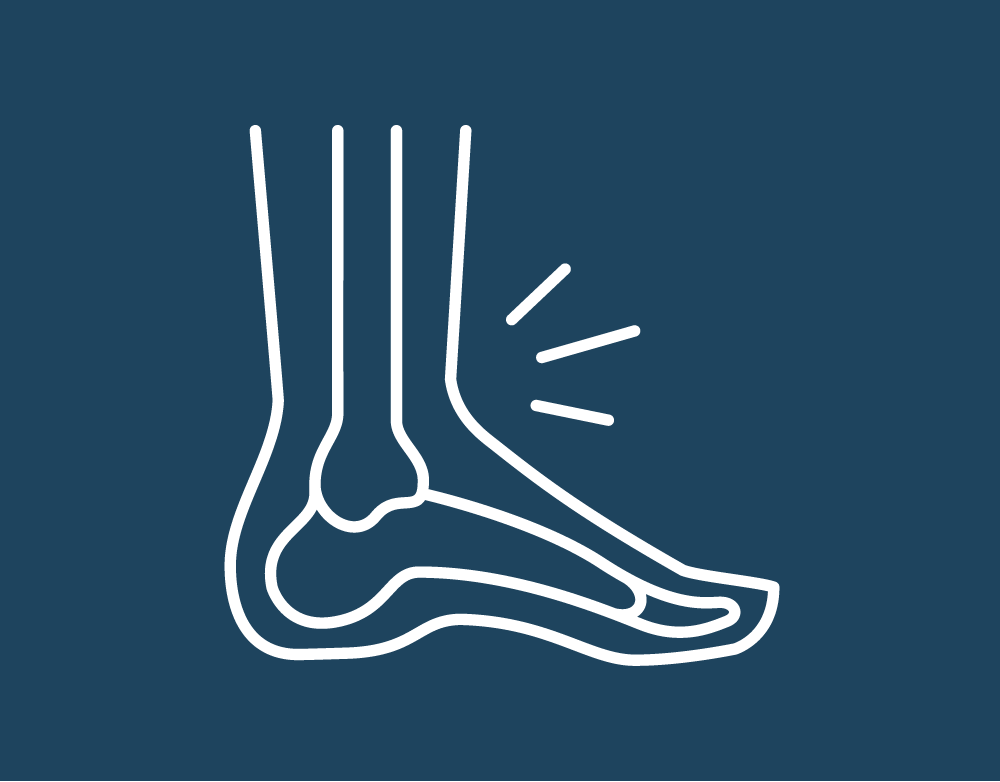
The foot and ankle joint
Our feet are a perfect interplay of bones, ligaments, and tendons.
With 26 bones, tendons, and muscles working perfectly together, the human foot is a masterpiece of anatomy essential for the stability and mobility of upright walking. Careful diagnosis and treatment of foot deformities or injuries are essential to maintain the full functionality of the body.
Symptoms
Osteoarthritis of the big toe’s metatarsophalangeal joint (Hallux rigidus)
The symptoms of osteoarthritis of the big toe’s metatarsophalangeal joint are varied and can worsen over the course of the condition. Typical signs include pain that occurs when bearing weight and moving the big toe. This pain may also be present at rest and can worsen at night. Stiffening of the big toe is another common symptom, leading to restricted mobility. This can affect the normal rolling and weight-bearing of the foot during walking and may cause difficulties when walking or standing. Early diagnosis and treatment are important to relieve symptoms and maintain foot mobility.
Plantar fasciitis (heel pain)
Plantar fasciitis, also known as heel pain, is a condition caused by inflammation of the connective tissue on the sole of the foot. This condition often arises from overuse of the foot muscles and can lead to persistent, activity-related pain. It is important to recognise the symptoms early and seek prompt treatment to allow for a full recovery and to prevent further problems. Seek advice so you can begin strengthening and protecting your feet.
Hallux valgus (bunion of the big toe)
Hallux valgus, also known as a bunion of the big toe, often develops due to improper loading of the foot, such as with a splayfoot, fallen arch, or flatfoot. This causes a lateral deviation of the first metatarsal bone at the base joint, pushing the bone’s head towards the inside of the foot and causing the big toe to angle towards the smaller toes. In advanced stages, deformities of the smaller toes may also develop. Poorly fitting shoes, a hereditary predisposition, rheumatic diseases, or, rarely, an injury can contribute to the formation of hallux valgus. This leads to painful deformities of the toes and forefoot, as well as the development of pressure sores, which impair the normal rolling motion of the foot when walking.
Metatarsalgia (forefoot pain)
Metatarsalgia is a painful overload of the metatarsal heads, which can be caused by various factors. These include unfavourable foot shapes, a reduction of the fat pad with age, inappropriate footwear, relative length differences of the metatarsal bones, or previous surgeries. Misalignments of the toes can also contribute to metatarsalgia. To avoid these complaints, it is important to choose suitable footwear and, if necessary, correct any deformities.
Hammer toes / Claw toes
A hammer toe or claw toe is characterised by an unnatural bending of the middle or end joint of the toe. This leads to a permanent deformity that can cause symptoms such as painful pressure points and calluses. This deformity can affect one or several toes simultaneously and is often caused by a splayfoot, but can also result from severe foot or lower leg injuries or other conditions.
Treatment of deformities that cause discomfort can be either surgical or non-surgical. To relieve pain and prevent pressure sores, we recommend proper footwear, the use of insoles and padding, and targeted pain medication. However, a surgical procedure is usually necessary for causal treatment of the deformities. The surgical approach depends on the specific anatomical situation. In some cases, a tendon procedure alone is sufficient, while in others, shortening of the proximal phalanx with temporary wire fixation, often combined with tendon correction, is required.
Morton’s neuroma
Pain in the forefoot area and sensory disturbances in the toes can be signs of Morton’s neuroma. This condition arises from irritation of the sensory nerves that run between the metatarsal bones and can gradually thicken into a nerve lump. Morton’s neuroma is a common and painful condition that should be treated to relieve pain and discomfort. The identification, decompression, and removal of the affected nerve segment or nerve thickening is performed gently and minimally invasively through a small incision on the top of the foot. This procedure allows us to successfully treat the symptoms without affecting the patient’s daily life. However, it may result in some loss of sensation in the affected toes, which is generally not found to be bothersome.
Your health is my top priority.
Diagnosis & Treatment
During a thorough doctor-patient consultation, I address your individual problem and any pain related to the affected joint.
The primary goal of treatment is the most precise identification of the cause of the illness or pain and clarification of the diagnosis. Together with you, I develop an individual, holistic therapy plan and accompany you throughout the healing process. Careful consideration is given as to whether conservative or surgical measures are necessary for successful treatment.
Possible treatment options
- Physiotherapy
- Oral medication therapies
- Injections (or Infiltrations)
- Surgery


